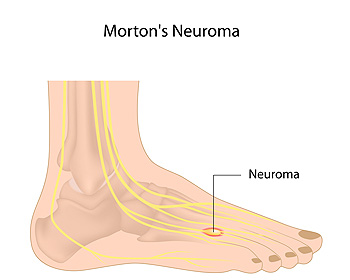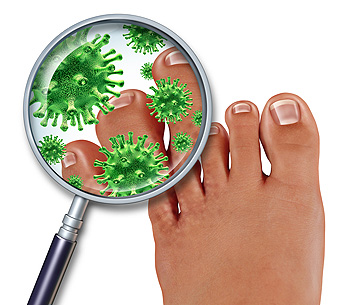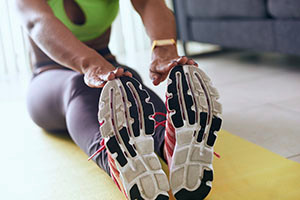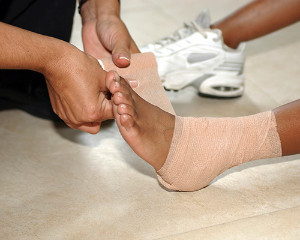Blog
Before you start dancing...
Sever’s Disease Typically Affects Teenagers
 The medical condition that is known as Sever’s disease typically occurs in early teenage years. It affects the growth plate in the heel, and can be common in children who participate in sporting activities. Research has indicated the tendons and muscles in the feet grow at different speeds, and performing repetitive motions can affect the heel area. You may notice your child experiencing specific symptoms, which may include walking on tip toes, limping, and the heel may appear to be red and swollen. Moderate relief can be felt when the foot is elevated, followed by taking mild pain medication. Additionally, it may be helpful to wear orthotics as the healing process takes place, which may provide adequate support. Treatment may be accelerated when the activity is stopped that caused the injury, in addition to possibly wearing a walking boot. If your child has developed Sever’s disease, it is advised that you schedule an appointment with a podiatrist who can properly treat this condition.
The medical condition that is known as Sever’s disease typically occurs in early teenage years. It affects the growth plate in the heel, and can be common in children who participate in sporting activities. Research has indicated the tendons and muscles in the feet grow at different speeds, and performing repetitive motions can affect the heel area. You may notice your child experiencing specific symptoms, which may include walking on tip toes, limping, and the heel may appear to be red and swollen. Moderate relief can be felt when the foot is elevated, followed by taking mild pain medication. Additionally, it may be helpful to wear orthotics as the healing process takes place, which may provide adequate support. Treatment may be accelerated when the activity is stopped that caused the injury, in addition to possibly wearing a walking boot. If your child has developed Sever’s disease, it is advised that you schedule an appointment with a podiatrist who can properly treat this condition.
Sever's disease often occurs in children and teens. If your child is experiencing foot or ankle pain, see Shaun J. Limon, DPM and Lisa Griffith-Limon, DPM from Limons Foot & Ankle Care. Our doctors can treat your child’s foot and ankle needs.
Sever’s Disease
Sever’s disease is also known as calcaneal apophysitis, which is a medical condition that causes heel pain I none or both feet. The disease is known to affect children between the ages of 8 and 14.
Sever’s disease occurs when part of the child’s heel known as the growth plate (calcaneal epiphysis) is attached to the Achilles tendon. This area can suffer injury when the muscles and tendons of the growing foot do not keep pace with bone growth. Therefore, the constant pain which one experiences at the back of the heel will make the child unable to put any weight on the heel. The child is then forced to walk on their toes.
Symptoms
Acute pain – Pain associated with Sever’s disease is usually felt in the heel when the child engages in physical activity such as walking, jumping and or running.
Highly active – Children who are very active are among the most susceptible in experiencing Sever’s disease, because of the stress and tension placed on their feet.
If you have any questions, please feel free to contact our offices located in Bradenton and Lakewood Ranch, FL . We offer the newest diagnostic and treatment technologies for all your foot and ankle injuries.
Read more about Sever's DiseasePossible Ways To Prevent Falling
Research has indicated that approximately one third of seniors in America will fall during the night. This can cause many injuries to occur, that may include painful foot ailments. There are methods that can be implemented which can help to reduce the risk of falling. These can consist of improving the lighting in the bedroom and hallways, removing worn carpeting, and installing grab bars in the shower and toilet areas. Many seniors find it beneficial to live in a home that has one level, and this can aid in preventing hazardous falls that may be caused by stairs. Additionally, it is helpful to incorporate a gentle exercise program into your daily routine. This can result in strengthening muscles which may also help to prevent falling. Please speak with a podiatrist if you would like more information on how falling may affect the feet.
Preventing falls among the elderly is very important. If you are older and have fallen or fear that you are prone to falling, consult with Shaun J. Limon, DPM and Lisa Griffith-Limon, DPM from Limons Foot & Ankle Care. Our doctors will assess your condition and provide you with quality advice and care.
Every 11 seconds, an elderly American is being treated in an emergency room for a fall related injury. Falls are the leading cause of head and hip injuries for those 65 and older. Due to decreases in strength, balance, senses, and lack of awareness, elderly persons are very susceptible to falling. Thankfully, there are a number of things older persons can do to prevent falls.
How to Prevent Falls
Some effective methods that older persons can do to prevent falls include:
- Enrolling in strength and balance exercise program to increase balance and strength
- Periodically having your sight and hearing checked
- Discuss any medications you have with a doctor to see if it increases the risk of falling
- Clearing the house of falling hazards and installing devices like grab bars and railings
- Utilizing a walker or cane
- Wearing shoes that provide good support and cushioning
- Talking to family members about falling and increasing awareness
Falling can be a traumatic and embarrassing experience for elderly persons; this can make them less willing to leave the house, and less willing to talk to someone about their fears of falling. Doing such things, however, will increase the likelihood of tripping or losing one’s balance. Knowing the causes of falling and how to prevent them is the best way to mitigate the risk of serious injury.
If you have any questions, please feel free to contact our offices located in Bradenton and Lakewood Ranch, FL . We offer the newest diagnostic and treatment technologies for all your foot care needs.
Read more about Falls PreventionWounds That Don't Heal Need to Be Checked
What Is A Heel Spur?
 Heel spurs, also known as calcaneal spurs or osteophytes, are bony outgrowths that can occur on the underside of a person’s foot. Heel spurs may be hooked, pointy, or shelf-like. There are many causes, but most often, heel spurs arise in patients with plantar fasciitis. This is an inflammation of the plantar fascia, the tissue that runs along the bottom of the foot and connects the heel to the toes. The heel can also become more vulnerable with age. The pads of the heel wear down and fail to provide shock absorption. The diagnosis of a heel spur is formally made when an X-ray reflects this bony protrusion. The first steps of treatment are rest, inflammation control, icing, stretching, and orthotics. If you are conflicted with this ailment, it is recommended to speak with your local podiatrist.
Heel spurs, also known as calcaneal spurs or osteophytes, are bony outgrowths that can occur on the underside of a person’s foot. Heel spurs may be hooked, pointy, or shelf-like. There are many causes, but most often, heel spurs arise in patients with plantar fasciitis. This is an inflammation of the plantar fascia, the tissue that runs along the bottom of the foot and connects the heel to the toes. The heel can also become more vulnerable with age. The pads of the heel wear down and fail to provide shock absorption. The diagnosis of a heel spur is formally made when an X-ray reflects this bony protrusion. The first steps of treatment are rest, inflammation control, icing, stretching, and orthotics. If you are conflicted with this ailment, it is recommended to speak with your local podiatrist.
Heel spurs can be incredibly painful and sometimes may make you unable to participate in physical activities. To get medical care for your heel spurs, contact Shaun J. Limon, DPM and Lisa Griffith-Limon, DPM from Limons Foot & Ankle Care. Our doctors will do everything possible to treat your condition.
Heels Spurs
Heel spurs are formed by calcium deposits on the back of the foot where the heel is. This can also be caused by small fragments of bone breaking off one section of the foot, attaching onto the back of the foot. Heel spurs can also be bone growth on the back of the foot and may grow in the direction of the arch of the foot.
Older individuals usually suffer from heel spurs and pain sometimes intensifies with age. One of the main condition's spurs are related to is plantar fasciitis.
Pain
The pain associated with spurs is often because of weight placed on the feet. When someone is walking, their entire weight is concentrated on the feet. Bone spurs then have the tendency to affect other bones and tissues around the foot. As the pain continues, the feet will become tender and sensitive over time.
Treatments
There are many ways to treat heel spurs. If one is suffering from heel spurs in conjunction with pain, there are several methods for healing. Medication, surgery, and herbal care are some options.
If you have any questions feel free to contact our offices located in Bradenton and Lakewood Ranch, FL . We offer the latest in diagnostic and treatment technology to meet your needs.
Read more about How to Treat Heel SpursNerve Damage May Lead to Morton’s Neuroma
 Pain and discomfort that is felt on the ball of the foot may indicate the presence of a condition that is known as Morton’s neuroma. Additionally, the pain may be felt at the base of the toes, and patients have noticed that it feels like they are standing on pebbles. Other symptoms can include numbness or tingling, and walking may be difficult. A common cause of this condition is wearing shoes that are too tight, and which do not have adequate room for the toes to move freely in. Wearing these types of shoes can cause irritation in the nerve, gradually putting pressure on that portion of the foot. There are existing medical conditions that are often associated with Morton’s neuroma. These can include bunions, hammertoes, and flat feet. After a proper diagnosis is performed, mild relief can be found in performing stretching techniques that may be helpful in loosening the tendons, in addition to elevating and massaging the affected foot. Please consult with a podiatrist if you feel you may have developed Morton’s neuroma, so that the proper treatment can begin.
Pain and discomfort that is felt on the ball of the foot may indicate the presence of a condition that is known as Morton’s neuroma. Additionally, the pain may be felt at the base of the toes, and patients have noticed that it feels like they are standing on pebbles. Other symptoms can include numbness or tingling, and walking may be difficult. A common cause of this condition is wearing shoes that are too tight, and which do not have adequate room for the toes to move freely in. Wearing these types of shoes can cause irritation in the nerve, gradually putting pressure on that portion of the foot. There are existing medical conditions that are often associated with Morton’s neuroma. These can include bunions, hammertoes, and flat feet. After a proper diagnosis is performed, mild relief can be found in performing stretching techniques that may be helpful in loosening the tendons, in addition to elevating and massaging the affected foot. Please consult with a podiatrist if you feel you may have developed Morton’s neuroma, so that the proper treatment can begin.
Morton’s neuroma is a very uncomfortable condition to live with. If you think you have Morton’s neuroma, contact Shaun J. Limon, DPM and Lisa Griffith-Limon, DPM of Limons Foot & Ankle Care. Our doctors will attend to all of your foot care needs and answer any of your related questions.
Morton’s Neuroma
Morton's neuroma is a painful foot condition that commonly affects the areas between the second and third or third and fourth toe, although other areas of the foot are also susceptible. Morton’s neuroma is caused by an inflamed nerve in the foot that is being squeezed and aggravated by surrounding bones.
What Increases the Chances of Having Morton’s Neuroma?
- Ill-fitting high heels or shoes that add pressure to the toe or foot
- Jogging, running or any sport that involves constant impact to the foot
- Flat feet, bunions, and any other foot deformities
Morton’s neuroma is a very treatable condition. Orthotics and shoe inserts can often be used to alleviate the pain on the forefront of the feet. In more severe cases, corticosteroids can also be prescribed. In order to figure out the best treatment for your neuroma, it’s recommended to seek the care of a podiatrist who can diagnose your condition and provide different treatment options.
If you have any questions, please feel free to contact our offices located in Bradenton and Lakewood Ranch, FL . We offer the newest diagnostic and treatment technologies for all your foot care needs.
Read more about What is Morton's Neuroma?It's Time for Beautiful Feet
Preventing Toenail Fungus
 Are you tired of hiding your toes in the sand? Are your toenails beginning to discolor, thicken, or crumble? This could be the beginning of toenail fungus. Fungi are nearly everywhere, and they particularly love dark, moist, and warm places, like inside your shoes. Healthy feet depend on healthy hygiene, so it’s important to keep your toes clean and dry. Cut your toenails straight across with a sanitized nail clipper. Wear breathable, properly fitted shoes and socks. Your toenails should never be touching your shoes. It also helps to alternate your shoes. If your feet sweat and your shoes are damp, it's time to go to the next pair while the other pair dry. Avoid going barefoot in public places, especially in locker rooms, showers, and pools. If you have tried at home remedies to clear your toenail fungus and it keeps returning, it may be time to follow up with your local podiatrist.
Are you tired of hiding your toes in the sand? Are your toenails beginning to discolor, thicken, or crumble? This could be the beginning of toenail fungus. Fungi are nearly everywhere, and they particularly love dark, moist, and warm places, like inside your shoes. Healthy feet depend on healthy hygiene, so it’s important to keep your toes clean and dry. Cut your toenails straight across with a sanitized nail clipper. Wear breathable, properly fitted shoes and socks. Your toenails should never be touching your shoes. It also helps to alternate your shoes. If your feet sweat and your shoes are damp, it's time to go to the next pair while the other pair dry. Avoid going barefoot in public places, especially in locker rooms, showers, and pools. If you have tried at home remedies to clear your toenail fungus and it keeps returning, it may be time to follow up with your local podiatrist.
If left untreated, toenail fungus may spread to other toenails, skin, or even fingernails. If you suspect you have toenail fungus it is important to seek treatment right away. For more information about treatment, contact Shaun J. Limon, DPM and Lisa Griffith-Limon, DPM of Limons Foot & Ankle Care. Our doctors can provide the care you need to keep you pain-free and on your feet.
Symptoms
- Warped or oddly shaped nails
- Yellowish nails
- Loose/separated nail
- Buildup of bits and pieces of nail fragments under the nail
- Brittle, broken, thickened nail
Treatment
If self-care strategies and over-the-counter medications does not help your fungus, your podiatrist may give you a prescription drug instead. Even if you find relief from your toenail fungus symptoms, you may experience a repeat infection in the future.
Prevention
In order to prevent getting toenail fungus in the future, you should always make sure to wash your feet with soap and water. After washing, it is important to dry your feet thoroughly especially in between the toes. When trimming your toenails, be sure to trim straight across instead of in a rounded shape. It is crucial not to cover up discolored nails with nail polish because that will prevent your nail from being able to “breathe”.
In some cases, surgical procedure may be needed to remove the toenail fungus. Consult with your podiatrist about the best treatment options for your case of toenail fungus.
If you have any questions, please feel free to contact our offices located in Bradenton and Lakewood Ranch, FL . We offer the newest diagnostic and treatment technologies for all your foot care needs.
Read more about Treating Toenail Fungus
Important Tips for Runners
 The majority of people who enjoy the sport of running and jogging are familiar with the pain and inconvenience of a running injury. This can be a result of not training properly, and the physical stress may be overwhelming for the body to endure. There are methods that can be implemented which may reduce the risk of running injuries. These can include increasing the mileage gradually, and properly stretching the leg and foot muscles. Additionally, it is important to rest between races or general running, and this can help to prevent stagnant results and plateau levels. If you are interested in pursuing running on a frequent basis, it is suggested that you consult with a podiatrist who can educate you on how to prevent running injuries.
The majority of people who enjoy the sport of running and jogging are familiar with the pain and inconvenience of a running injury. This can be a result of not training properly, and the physical stress may be overwhelming for the body to endure. There are methods that can be implemented which may reduce the risk of running injuries. These can include increasing the mileage gradually, and properly stretching the leg and foot muscles. Additionally, it is important to rest between races or general running, and this can help to prevent stagnant results and plateau levels. If you are interested in pursuing running on a frequent basis, it is suggested that you consult with a podiatrist who can educate you on how to prevent running injuries.
Exercising your feet regularly with the proper foot wear is a great way to prevent injuries. If you have any concerns about your feet, contact Shaun J. Limon, DPM and Lisa Griffith-Limon, DPM of Limons Foot & Ankle Care. Our doctors will treat your foot and ankle needs.
How to Prevent Running Injuries
Many common running injuries are caused by overuse and overtraining. When the back of the kneecap starts wearing out and starts causing pain in your knee, this is commonly referred to as runner’s knee. Runner’s knee is a decrease in strength in your quadriceps and can occur if you’re not wearing properly fitted or supporting shoes. To prevent runner’s knee, focusing on hip strengthening is a good idea, as well as strengthening your quads to keep the kneecaps aligned.
What Are Some Causes of Running Injuries?
- One cause of a common running injury is called iliotibial band syndrome.
- Plantar fasciitis is also another common injury.
- Stress fractures can occur from overtraining, lack of calcium, or even your running style.
Best Ways to Prevent Running Injuries
- Wear footwear that fits properly and suits your running needs.
- Running shoes are the only protective gear that runners have to safeguard them from injury.
- Make a training schedule. Adding strengthening exercises as well as regular stretching can help keep you strong and limber and can lessen the possibility of injuries.
- Stretching keeps muscles limber; this will help you gain better flexibility.
If you have any questions please feel free to contact our offices located in Bradenton and Lakewood Ranch, FL . We offer the newest diagnostic and treatment technologies for all your foot and ankle needs.
Read more about How to Prevent Running InjuriesHeel Pain Can Be Treated!
More...
An Overview of Plantar Fasciitis
The plantar fascia is a rigid, thick tissue that con nects the heel bone to the toes. Plantar fasciitis occurs when the plantar fascia becomes inflamed. Causes include rapid weight gain, excessive exercise, flat feet, improper footwear and prolonged standing. The most common symptoms are heel swelling and/or stiffness, sharp or dull pain at the bottom of the foot and pain that worsens with the more weight that is put on it. The treatment options for plantar fasciitis are fairly basic. They are rest, applying ice, stretching and muscle strengthening exercises. Strategies that can be used to prevent plantar fasciitis from recurring are losing weight, wearing supportive, well-cushioned footwear, regularly performing plantar fascia stretching exercises and switching to low-impact forms of exercise such as swimming and stationary cycling. If you are experiencing any symptoms of plantar fasciitis, it is advised to consult with a podiatrist for the best treatment options.
nects the heel bone to the toes. Plantar fasciitis occurs when the plantar fascia becomes inflamed. Causes include rapid weight gain, excessive exercise, flat feet, improper footwear and prolonged standing. The most common symptoms are heel swelling and/or stiffness, sharp or dull pain at the bottom of the foot and pain that worsens with the more weight that is put on it. The treatment options for plantar fasciitis are fairly basic. They are rest, applying ice, stretching and muscle strengthening exercises. Strategies that can be used to prevent plantar fasciitis from recurring are losing weight, wearing supportive, well-cushioned footwear, regularly performing plantar fascia stretching exercises and switching to low-impact forms of exercise such as swimming and stationary cycling. If you are experiencing any symptoms of plantar fasciitis, it is advised to consult with a podiatrist for the best treatment options.
Plantar fasciitis is a common foot condition that is often caused by a strain injury. If you are experiencing heel pain or symptoms of plantar fasciitis, contact Shaun J. Limon, DPM and Lisa Griffith-Limon, DPM from Limons Foot & Ankle Care. Our doctors can provide the care you need to keep you pain-free and on your feet.
What Is Plantar Fasciitis?
Plantar fasciitis is one of the most common causes of heel pain. The plantar fascia is a ligament that connects your heel to the front of your foot. When this ligament becomes inflamed, plantar fasciitis is the result. If you have plantar fasciitis you will have a stabbing pain that usually occurs with your first steps in the morning. As the day progresses and you walk around more, this pain will start to disappear, but it will return after long periods of standing or sitting.
What Causes Plantar Fasciitis?
- Excessive running
- Having high arches in your feet
- Other foot issues such as flat feet
- Pregnancy (due to the sudden weight gain)
- Being on your feet very often
There are some risk factors that may make you more likely to develop plantar fasciitis compared to others. The condition most commonly affects adults between the ages of 40 and 60. It also tends to affect people who are obese because the extra pounds result in extra stress being placed on the plantar fascia.
Prevention
- Take good care of your feet – Wear shoes that have good arch support and heel cushioning.
- Maintain a healthy weight
- If you are a runner, alternate running with other sports that won’t cause heel pain
There are a variety of treatment options available for plantar fasciitis along with the pain that accompanies it. Additionally, physical therapy is a very important component in the treatment process. It is important that you meet with your podiatrist to determine which treatment option is best for you.
If you have any questions, please feel free to contact our offices located in Bradenton and Lakewood Ranch, FL . We offer the newest diagnostic and treatment technologies for all your foot care needs.
Read more about Plantar Fasciitis
Ligaments and Ankle Sprains
There are several ways ankle sprains can occur. It happens once the supporting ligaments become injured when the ankle is twisted, possibly resulting from stepping off a curb unexpectedly. The symptoms that are often associated with sprained ankles can include pain and discomfort surrounding the affected ankle, and the ankle may appear bruised and swollen. Many patients find it difficult to walk, and may have to use crutches. After a proper diagnosis is performed, which consists of having an X-ray taken, the treatment process can begin. It is important to elevate the ankle, as this may help to reduce any existing swelling. If you feel you have sprained your ankle, please consider scheduling a consultation with a podiatrist who can guide you toward beginning the proper treatment.
Ankle sprains are common but need immediate attention. If you need your feet checked, contact Shaun J. Limon, DPM and Lisa Griffith-Limon, DPM from Limons Foot & Ankle Care. Our doctors can provide the care you need to keep you pain-free and on your feet.
How Does an Ankle Sprain Occur?
Ankle sprains take place when the ligaments in your ankle are torn or stretched beyond their limits. There are multiple ways that the ankle can become injured, including twisting or rolling over onto your ankle, putting undue stress on it, or causing trauma to the ankle itself.
What Are the Symptoms?
- Mild to moderate bruising
- Limited mobility
- Swelling
- Discoloration of the skin (depending on severity)
Preventing a Sprain
- Wearing appropriate shoes for the occasion
- Stretching before exercises and sports
- Knowing your limits
Treatment of a Sprain
Treatment of a sprain depends on the severity. Many times, people are told to rest and remain off their feet completely, while others are given an air cast. If the sprain is very severe, surgery may be required.
If you have suffered an ankle sprain previously, you may want to consider additional support such as a brace and regular exercises to strengthen the ankle.
If you have any questions please feel free to contact our offices located in Bradenton and Lakewood Ranch, FL . We offer the newest diagnostic and treatment technologies for all your foot and ankle needs.
Read more about Ankle SprainsReminder: When Was the Last Time...?
Laser Treatment of Toenail Fungus
If you have toenail fungus, laser tr eatment may be the answer. Some symptoms of fungal nails include yellow, white, or brown nail discoloration, thickening of the nail or change in texture, change in shape of the nail and any flaky debris that is present under or on the nail. The FDA has approved a few different types of laser devices for the treatment of onychomycosis, which is another name for a fungal nail infection. Some of the laser devices include PinPointe Footlaser, GenesisPlus and Noveon. These laser devices kill off the nail fungus by emitting pulses of energy that impart heat to the infected tissue on the nail. When the fungus on the nail absorbs the heat from the laser treatment, it will begin to die off. While some patients will have success with a single laser treatment, additional treatments can be prescribed depending on the results. This most often depends on the type of laser treatment being utilized. Laser treatment can be a more expensive method, but it also happens to be the most efficient. If you are dealing with toenail fungus and are interested in laser treatment, consult with a podiatrist.
eatment may be the answer. Some symptoms of fungal nails include yellow, white, or brown nail discoloration, thickening of the nail or change in texture, change in shape of the nail and any flaky debris that is present under or on the nail. The FDA has approved a few different types of laser devices for the treatment of onychomycosis, which is another name for a fungal nail infection. Some of the laser devices include PinPointe Footlaser, GenesisPlus and Noveon. These laser devices kill off the nail fungus by emitting pulses of energy that impart heat to the infected tissue on the nail. When the fungus on the nail absorbs the heat from the laser treatment, it will begin to die off. While some patients will have success with a single laser treatment, additional treatments can be prescribed depending on the results. This most often depends on the type of laser treatment being utilized. Laser treatment can be a more expensive method, but it also happens to be the most efficient. If you are dealing with toenail fungus and are interested in laser treatment, consult with a podiatrist.
Laser treatment can be an effective way to get rid of toenail fungus. If you have any questions about laser treatment, consult with Shaun J. Limon, DPM and Lisa Griffith-Limon, DPM from Limons Foot & Ankle Care. Our doctors will assess your condition and provide you with quality treatment for fungal nails.
What Are Toenail Fungal Infections?
Onychomycosis, or fungal infection of the nail, is a relatively common and non-serious condition. Around 10 percent of U.S. citizens are afflicted with fungal nails. Common forms of fungus that infect the nail include dermatophytes, yeasts, and molds.
Symptoms of Toenail Fungal Infections Include:
- Nail thickening
- Brittleness of the nail
- Discoloration of the nail
Diagnosis for Fungal Nails
Fungal infections are diagnosed by fungal culture and microscopy. This will rule out any other conditions such as nail trauma, psoriasis, lichen planus, and onychogryphosis.
What Is Laser Treatment?
Laser treatment is a non-invasive, safe, quick, and painless procedure that uses the heat from a laser to kill fungus in the nail. Each infected nail is targeted with a laser for several minutes. The treatment is usually utilized several different times over a select period. During this time, a podiatrist will keep an eye on the infection.
If you have any questions, please feel free to contact our offices located in Bradenton and Lakewood Ranch, FL . We offer the newest diagnostic and treatment technologies for all your foot care needs.
Read more about Laser Treatment for Fungal Nails






